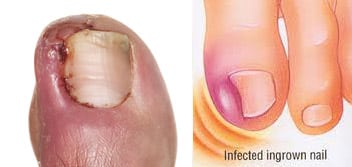Ingrown or ingrowing toenails are incredibly common and can affect people of all ages. Though they can be incredibly uncomfortable they’re nothing to be ashamed of and as we’ll explain in this post, ingrown toenail treatment is simple and straightforward, so read on to learn more about the causes and treatments for ingrown toenails.
What is an ingrowing toenail?
An ingrown toenail occurs when a toenail, usually on your big toe – although it can happen to any toe – starts to grow abnormally. The sides of the nail begin to dig into the skin tissue causing pain as the nail continues to grow. The impinged skin surrounding the nail can become inflamed, red and sore and this causes a great deal of discomfort if not treated.

What causes ingrown toenails?
There are a number of causes of ingrown toenails and they can afflict anybody at any time though are particularly common in people in their teens and 20s. Contrary to popular misconceptions foot hygiene is not a factor but restrictive footwear can play a part. So don’t blame your soap but do consider your shoes!
Poorly cut nails can also lead to ingrowing toenails although for some people the problem will have no obvious root cause and cases can be purely congenital. Additionally, it’s not uncommon to suffer from ingrowing toenails following damage to the foot such as by stubbing your toe.
In all cases however identifying the cause is largely irrelevant and focus should be placed on rectifying the issue once you’ve discovered it.
How can you prevent ingrown toenails?
Avoiding excessively restrictive footwear, keeping your nails neatly trimmed and doing your best to avoid bashing your toes (easier said than done for some people!) will give you a higher chance of avoiding ingrowing toenails but as previously mentioned, in some cases it’s simply a congenital condition so no amount of preventative measures will protect you.
When cutting your toenails, it’s best to avoid tapering or rounding the edges, as this can encourage abnormal growth. A clean straight line is generally a safer option.
Don’t be disheartened however if you still suffer from an ingrown toenail despite taking steps to mitigate your chances of needing treatment. For many people an ingrown toenail is unavoidable and hasn’t been caused by anything you have or haven’t done.
What are the complications with ingrown toenails?
Unfortunately, once the nail has started growing abnormally it is very unlikely to get better without treatment, so don’t ignore the problem and hope it goes away. If left untreated the ingrowing toenail can lead to an infection and the inflamed skin will begin to discharge pus which isn’t generally very pleasant!
Once an infection has set in the problem can rapidly become very serious so it’s wise to take steps to address an ingrown toenail as soon as you become aware of it, to prevent the situation from getting worse and the discomfort getting unbearable.
What ingrown toenail treatment is available?
This incredibly common problem won’t do you any long-term harm as long as it’s treated in a timely manner and there are a number of options available however you should contact your GP for examination if your symptoms are more serious, such as having sore, red, inflamed skin that is producing pus.
Early-stage identification and pain management
Some people find that managing the pain with paracetamol and/or ibuprofen can help, coupled with wearing comfortable open toed shoes like sandals, to help soothe the impacted area. This method is suitable for management of the condition in the short term, provided infection hasn’t set in. But it’s important to recognise that painkillers won’t combat an infected toe so you need to be sure the affliction is in the early stages and if your toe is excessively swollen, you’ll want to speak to your GP to get antibiotics.
You can also soak your foot in warm water to help alleviate the symptoms, but again this won’t have a great deal of effect if an infection has set in. If in doubt speak to your doctor.
Antibiotics for infections
One of the most common ingrown toenail treatments is taking a course of antibiotics as prescribed by your GP. This should reduce the inflammation and relieve the pain and discomfort you’re feeling. However, this treatment doesn’t target the root cause of the problem.
Antibiotics will help in the short term and will often appear to have resolved the issue all together but without addressing the underlying issue of the abnormally growing toenail, symptoms can return, the cycle starts again and the problem reoccurs. In fact, ingrowing toenails can afflict a person over and over again with seemingly no end in sight if preventative treatment is not taken.
Nail surgery
A more suitable long-term solution is to undergo nail surgery to remove the ingrowing nail. Known as partial nail avulsion, this minimally invasive procedure is carried out using local anaesthetic making it pain-free with no cutting of the skin and no stitches required.
This preventative long term ingrown toenail treatment involves removing 3-4mm from the edge of the problem nail, leaving over 90% of it untouched. Then the nail bed is treated with a preventative nail regrowth formula to keep the cells responsible for nail growth from repeating the problem in the future.
The Waverley Foot Clinic approach
As a specialist podiatrist and chiropodist Waverley Foot Clinic have been treating ingrown toenails for over ten years. We see and treat people’s feet every week so you can rest assured you’re in good hands with us.
You can find out more about the best treatment on our nail surgery page or get in touch with a member of the team if you’d like to know more and we’ll be happy to talk you through the process.
Don’t suffer in silence, treat the root cause of your foot pain and before long you’ll be showing off your feet without shame or embarrassment!
